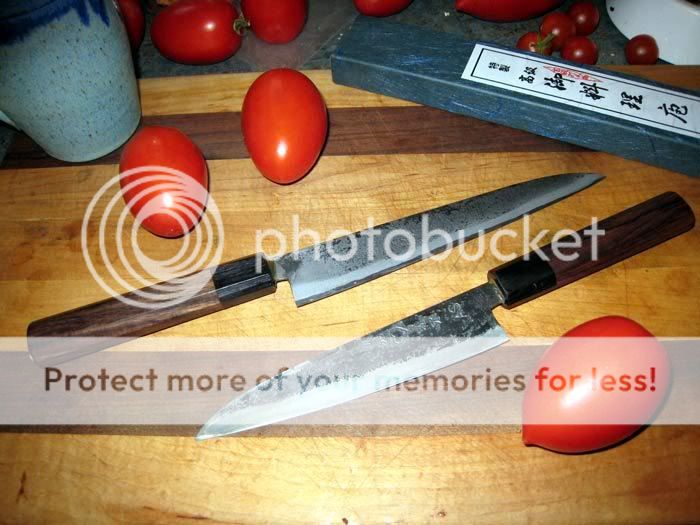- Joined
- Jul 3, 2007
- Messages
- 392
I wanted a high carbon chef knife for years.
I had to beg, plead, wheedle, and blackmail Jim Rodebaugh, MS, to forge me a high carbon blade in a french curve, not to mention the waiting list. Getting him to make it to my specs was fun, too. He has made one other to my pattern for someone else.
The result, out of L6 and desert ironwood, is spectactular and I use it every day!!! That's it in my signature avatar. I am a former professional chef and know what I want in a knife for the task. I can fine dice on the tip, and break chix bones with the back. I wanted it to be built sturdy, but not clunky. It is simply the finest chef knife I have held in my hand.
Far too many people make their chef knives clunky and heavy with a screwed up taper. If you really don't know what you are doing, I say don't make these types of knives...it really takes some delicasy to do it right and the heat treating is apparently tricky. Most of the ones that I see are stock removal knives, too. My preference runs to a forged blade, and from what I understand it is pretty difficult to forge a chefs knife completely. Many of the makers I have talked to shy away from chefs knives, because they are difficult to do right.
I had to beg, plead, wheedle, and blackmail Jim Rodebaugh, MS, to forge me a high carbon blade in a french curve, not to mention the waiting list. Getting him to make it to my specs was fun, too. He has made one other to my pattern for someone else.
The result, out of L6 and desert ironwood, is spectactular and I use it every day!!! That's it in my signature avatar. I am a former professional chef and know what I want in a knife for the task. I can fine dice on the tip, and break chix bones with the back. I wanted it to be built sturdy, but not clunky. It is simply the finest chef knife I have held in my hand.
Far too many people make their chef knives clunky and heavy with a screwed up taper. If you really don't know what you are doing, I say don't make these types of knives...it really takes some delicasy to do it right and the heat treating is apparently tricky. Most of the ones that I see are stock removal knives, too. My preference runs to a forged blade, and from what I understand it is pretty difficult to forge a chefs knife completely. Many of the makers I have talked to shy away from chefs knives, because they are difficult to do right.




